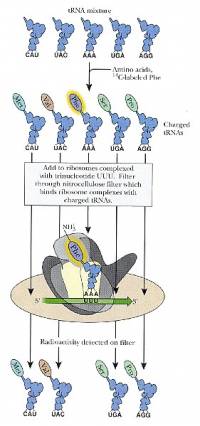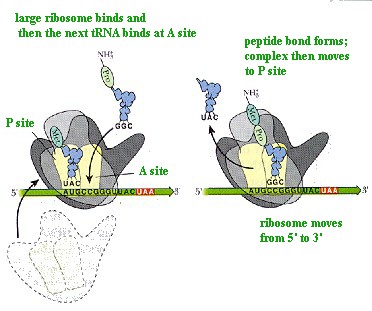Before cell division, the DNA in our chromosomes replicates so each daughter cell has an identical set of chromosome. In addition, the DNA is responsible for coding for all proteins. Each amino acid is designated by one or more set of triplet nucleotides. The code is produced from one strand of the DNA by a process called "transcription". This produces mRNA which then is sent out of the nucleus where the message is translated into proteins. This can be done in the cytoplasm on clusters of ribosomes, called "polyribosomes". Or it can be done on the membranes of the rough endoplasmic reticulum. The cartoon to the left shows the basic sequence of transcription and translational events.
What happens at the site of the ribosome?
 | The code is actually translated on structures that are also made in the nucleus, called Ribosomes. These ribosomes provide the structural site where the mRNA sits. The amino acids for the proteins are carried to the site by "transfer RNAs,". In the cartoon to the left, these are shown as blue molecules. Each transfer RNA (tRNA) has a nucleotide triplet which binds to the complementary sequence on the mRNA (see the three letters at the bottom of each molecule).
|
The tRNA carries the amino acid at its opposite end. One can trace and detect binding of a particular tRNA-amino acid complex to the mRNA by labeling that amino acid. It will bind to its tRNA. In the case to the left, Phenylalanine is bound to the tRNA which carries the complementary base code AAA (adenine-adenine-adenine). This triplet code would bind to the complementary sequence on mRNA UUU (uracil X3). The mRNA is shown as a green arrow. This cartoon shows the selective binding site on the mRNA which is attached in the ribosome. It also shows the tRNA carrying the Phenylalanine bound at the site In this particular assay which uses a polyuracil mRNA, only phenylalanine-bearing tRNA is bound and detected on the filter.
Initiation
The cartoon shows the initiation of this process. It begins with the small subunit of the ribosome bound to the mRNA. An initiator tRNA is attracted to the region (carrying a methionine. It binds to the triplet code AUG.
This then attracts the large ribosomal subunit which will bind to the small subunit. Note that it has an A site and a P site. These are different binding sites for the tRNAs. The cartoon below describes the next phase in the process.
Elongation
In this cartoon, note that the initiator tRNA complex has moved to the P site. This leaves the A site open for the next tRNA. In this case, we have Proline, which carries the complementary code GGC. Note that its binding site on the mRNA is CCG. After binding to the A site, the peptide bond between the methionine and proline forms. The empty tRNA carrying the MET leaves and the tRNA carrying the Proline moves to the P site. The ribosome moves to the next triplet code from 5' to the 3' direction (note arrow on mRNA). The tRNAs are moving from 3' to the 5' direction as the ribosome reads the code

The ribosome continues to read the code from the 5' to the 3' and amino acids are added to the growing peptide chain. This one shows the tRNA carrying the glycine amino acid coded by CCA. Its complementary bases are GGU.
This continues until the stop codon is reached. This is highlighted in red in this figure and the next figure.
The following cartoon shows what happens when the stop codon is reached.
End of translation




